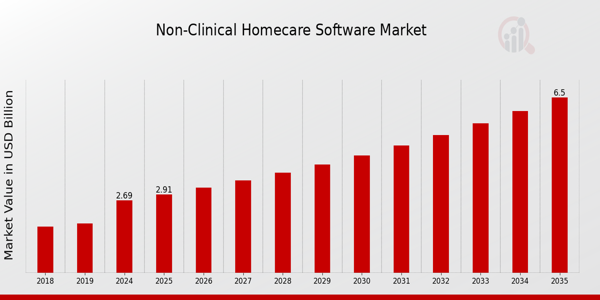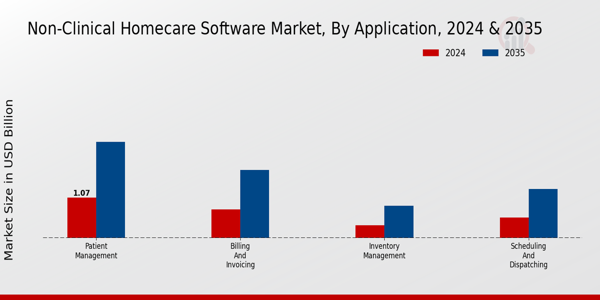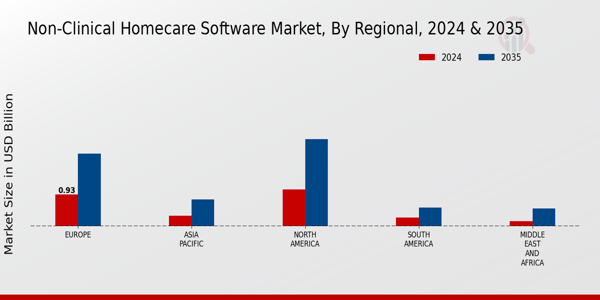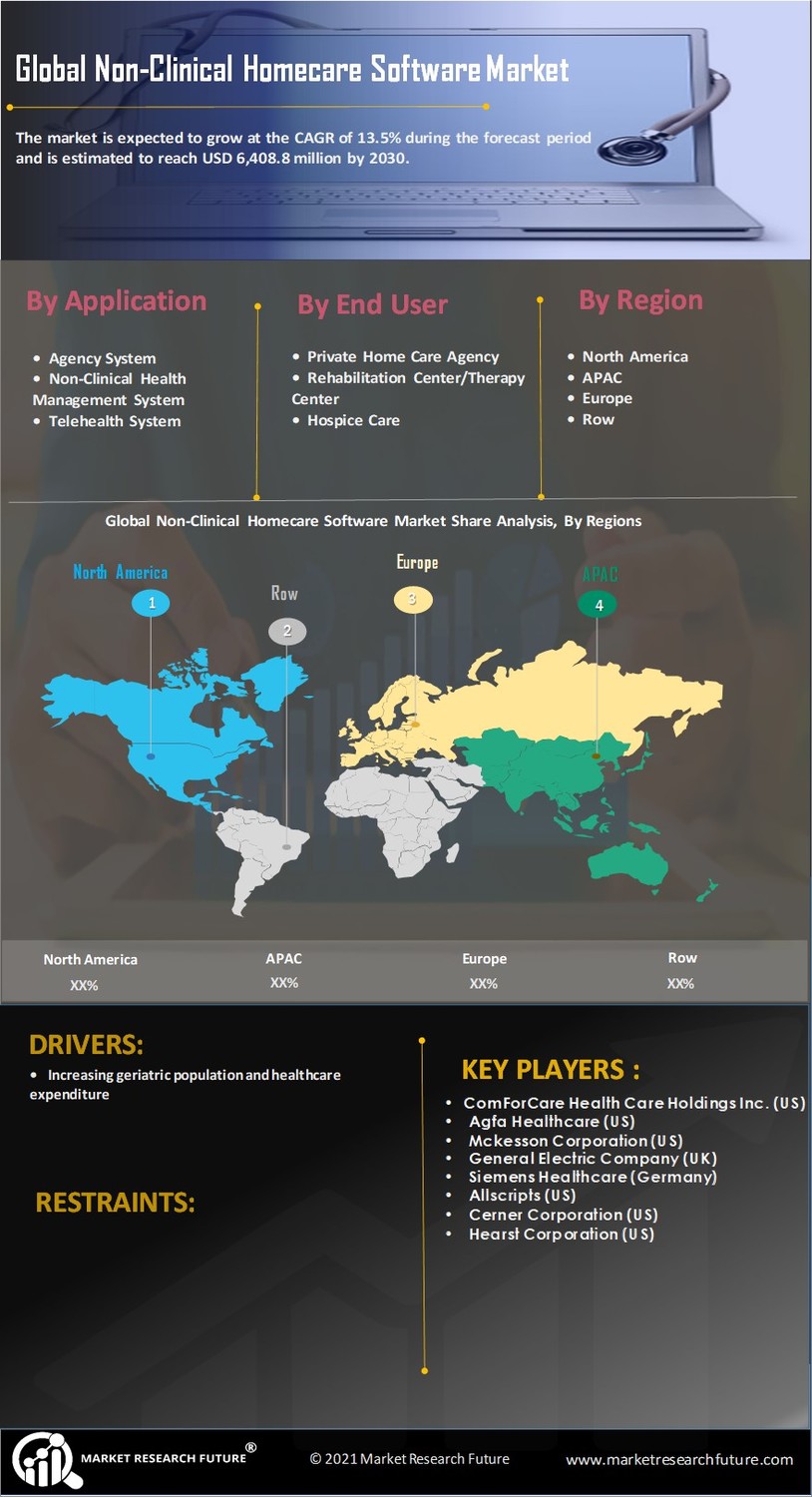Non-Clinical Homecare Software Market Overview
As per MRFR analysis, the Non-Clinical Homecare Software Market Size was estimated at 2.48 (USD Billion) in 2023. The Non-Clinical Homecare Software Market Industry is expected to grow from 2.69 (USD Billion) in 2024 to 6.5 (USD Billion) by 2035.
The Non-Clinical Homecare Software Market CAGR (growth rate) is expected to be around 8.35% during the forecast period (2025 - 2035).
Key Non-Clinical Homecare Software Market Trends Highlighted
The Non-Clinical Homecare Software Market is currently experiencing notable trends driven by the urgent need for improved home healthcare services. A key market driver is the rising aging population worldwide, particularly in developed regions, which necessitates efficient management of patient health.
This demographic shift pushes healthcare providers to adopt non-clinical homecare software solutions that enhance operational efficiency. Moreover, advancements in technology, such as telehealth services and mobile health applications, are further propelling this market.
These innovations enable caregivers to manage patients’ needs remotely, providing greater convenience and accessibility to homecare services. Healthcare entities are increasingly acknowledging the importance of integrated systems that provide comprehensive solutions.
This presents a plethora of opportunities in this market. Vendors are presented with the opportunity to create customized solutions for a variety of healthcare settings, as there is an increasing interest in software that can simplify patient administration, billing, and scheduling.
The emphasis on data security and privacy also creates opportunities for software that adheres to global regulations and safeguards sensitive patient information. In recent years, there has been a substantial transition to cloud-based solutions, which have enabled healthcare organizations to achieve greater cost-effectiveness and scalability.
New developments are being influenced by the demand for interoperability among various healthcare systems, as users seek software that can communicate seamlessly with existing platforms.
This trend underscores the increasing demand for comprehensive homecare solutions that not only provide services but also seamlessly integrate with other healthcare technologies on a global scale.
Overall, the non-clinical homecare software market is undergoing a rapid transformation, which is being fueled by technological advancements, demographic demands, and the pursuit of improved patient care management.

Source: Primary Research, Secondary Research, Market Research Future Database and Analyst Review
Non-Clinical Homecare Software Market Drivers
Increasing Demand for Home Healthcare Services
The rise in chronic diseases globally has significantly boosted the demand for home healthcare services. According to the World Health Organization, approximately 60% of the existing global disease burden is attributable to chronic conditions, which is projected to grow further.
This situation urges healthcare providers to adopt non-clinical homecare software solutions for effective management and service delivery. Major organizations like the International Home Care Association are advocating for increased home care services.
They emphasize how facilitating an aging population with chronic diseases will drive the Non-Clinical Homecare Software Market Industry. The efficiency this software brings in managing patient data, scheduling, and communication among caregivers positions it as a fundamental requirement for home care agencies and shops aiming to provide healthcare alternatives at home.
Technological Advancements in Software Solutions
Recent technological strides, particularly in artificial intelligence and data analytics, have transformed the landscape of non-clinical homecare software. These advancements enable more efficient patient management and improve outcomes.
As noted in a report by the American Society on Aging, digital health technologies are anticipated to provide substantial improvements in patient engagement and clinical outcomes, particularly in homecare settings.
Established entities like Cerner Corporation have started integrating advanced technologies into their software systems to enhance user experience and operational effectiveness.
Thus, these innovations are poised to significantly accelerate growth in the Non-Clinical Homecare Software Market Industry, ensuring better compliance with healthcare regulations and improved patient care workflows.
Aging Population and Associated Health Challenges
Globally, the aging population is set to rise exponentially, with the United Nations projecting that the number of people aged 60 years and older will reach 2.1 billion by 2050.
This demographic shift creates an urgent need for more efficient homecare solutions to manage the complexities associated with age-related health issues. The increase in geriatric patients suffering from multiple comorbidities necessitates the use of non-clinical homecare software for better care coordination and monitoring.
Organizations such as the World Health Organization are advocating for integrated care systems that leverage technology to support the elderly, thus spurring the growth of the Non-Clinical Homecare Software Market Industry.
Non-Clinical Homecare Software Market Segment Insights
Non-Clinical Homecare Software Market Application Insights
The Non-Clinical Homecare Software Market, particularly within the Application segment, demonstrates robust growth potential driven by increased demand for efficient management solutions in homecare settings.
The market growth can be largely attributed to technological advancements, the rising aging population, and the shift towards home-based care services. Among the various Applications, Patient Management stands out as a dominant segment, with a valuation of 1.07 USD Billion in 2024.
It is expected to grow significantly to 2.55 USD Billion by 2035. This segment's importance derives from its critical role in enhancing the quality of care, ensuring patient safety, and facilitating communication between caregivers and patients.
Meanwhile, the Billing and Invoicing Application also holds a significant position, with its market value projected at 0.75 USD Billion in 2024 and expanding to 1.8 USD Billion by 2035.
Efficient billing processes are essential for healthcare providers to maintain revenue flow and manage accounts receivable effectively, emphasizing this segment's role in the financial management of homecare services.
Additionally, Scheduling and Dispatching is a vital Application with a market value of 0.54 USD Billion in 2024, which is expected to reach 1.3 USD Billion by 2035; its importance lies in streamlining operations, reducing delays in service delivery, and enhancing overall patient satisfaction through timely visits.
Lastly, the Inventory Management segment, although smaller, also plays a critical role with a valuation of 0.33 USD Billion in 2024, anticipated to grow to 0.85 USD Billion by 2035.
It ensures that necessary supplies are available for patient care, thus avoiding interruptions in services. This diverse segmentation reflects the Non-Clinical Homecare Software Market's aim to address various operational challenges faced by homecare providers, highlighting the significance of each Application in driving efficiency and quality in care delivery.
The surge in demand for these solutions indicates a growing recognition of the need for technology in enhancing homecare services, presenting both opportunities for advancement and challenges in implementation across the Global landscape.

Source: Primary Research, Secondary Research, Market Research Future Database and Analyst Review
Non-Clinical Homecare Software Market Deployment Model Insights
The Non-Clinical Homecare Software Market, particularly focusing on the Deployment Model segment, is witnessing robust growth as the industry adapts to various operational needs.
Numerous organizations are transitioning towards Cloud-Based solutions due to their flexibility and cost-effectiveness, which allows for remote access and scalability. On-Premise systems remain relevant, particularly among organizations that prioritize data privacy and security, ensuring that sensitive information is managed internally.
Meanwhile, Hybrid models are gaining traction as they offer a balanced approach, combining the benefits of both Cloud-Based and On-Premise solutions. This diversity within the Deployment Model contributes to the overall effectiveness of the Non-Clinical Homecare Software Market and aligns with the growing global emphasis on personalized homecare services.
As technology continues to evolve, the importance of these deployment options is expected to further influence the market dynamics, allowing healthcare providers to deliver enhanced patient care while managing resources efficiently.
Non-Clinical Homecare Software Market End User Insights
The Non-Clinical Homecare Software Market is showing significant value as it aligns with the needs of various End Users, including Homecare Agencies, Nursing Facilities, Hospitals, and Individual Care Providers.
The segments within this framework highlight that Homecare Agencies are critical, as they handle a large portion of homecare services, driving the demand for efficient software solutions. Nursing Facilities also leverage this technology to streamline operations and enhance patient care.
Hospitals utilize non-clinical software to manage administrative functions effectively. Individual Care Providers are increasingly employing such software to optimize their service delivery, respond to caregiver needs, and maintain compliance with regulations.
The expected CAGR of 8.35% from 2025 to 2035 indicates a growing recognition of the importance of these software solutions across all End Users, reflecting broader trends in the healthcare sector towards automation and improved patient management.
Overall, the Non-Clinical Homecare Software Market data suggests robust growth will continue across diverse applications within these segments in the coming years.
Non-Clinical Homecare Software Market Features Insights
The Non-Clinical Homecare Software Market, valued at 2.69 USD Billion in 2024, showcases significant advancements in its Features segment, which includes Mobile Access, Reporting and Analytics, User Management, and Compliance Management.
Mobile Access is crucial as it facilitates healthcare professionals to manage patient care efficiently from various locations, ensuring timeliness and responsiveness. Meanwhile, Reporting and Analytics are vital for tracking performance metrics, enabling organizations to make informed decisions and improve patient outcomes.
User Management features play a critical role in ensuring that only authorized personnel can access sensitive patient information, thus enhancing data security. Compliance Management is significant as it helps organizations meet regulatory requirements, mitigating risks associated with non-compliance.
As these features gain traction, the Non-Clinical Homecare Software Market segmentation reflects an industry increasingly focused on delivering flexible, data-driven solutions that cater to the evolving needs of homecare providers.
The anticipated growth in this sector is largely driven by the rising demand for efficient homecare solutions and the growing emphasis on patient-centric care across the Global landscape.
Non-Clinical Homecare Software Market Regional Insights
When analyzing the market segmentation regionally, North America emerges as a dominant force, with an expected valuation of 1.07 USD Billion in 2024 and evolving to 2.55 USD Billion by 2035, contributing to the majority holding in the market.
Europe follows closely as the second major region, valued at 0.93 USD Billion in 2024, set to increase to 2.12 USD Billion by 2035, demonstrating robust demand driven by an aging population and rising healthcare costs.
South America, while smaller with a valuation of 0.25 USD Billion in 2024, showcases growth potential as awareness of homecare solutions enhances, expected to reach 0.54 USD Billion by 2035.
The Asia Pacific region presents significant opportunities for expansion due to increasing digitalization in healthcare, moving from a value of 0.3 USD Billion in 2024 to 0.78 USD Billion in 2035.
Furthermore, the Middle East and Africa, although the smallest segment with an anticipated valuation of 0.14 USD Billion in 2024, shows a promising trajectory, projected to reach 0.51 USD Billion by 2035, driven by rising investments in healthcare technology and growing populations.
Overall, the regional dynamics highlight the varied growth trajectories across different segments, with North America and Europe leading, while others like Asia Pacific and South America present emerging opportunities.

Source: Primary Research, Secondary Research, Market Research Future Database and Analyst Review
Non-Clinical Homecare Software Market Key Players and Competitive Insights
The Non-Clinical Homecare Software Market is characterized by a rapidly evolving landscape driven by technological advancements and increasing demand for remote healthcare solutions.
Various companies within this market are competing to offer innovative software solutions that enhance the efficiency and effectiveness of homecare services without the need for direct clinical involvement.
The competition is fueled by the rising need for personalized homecare, the growing aging population, and a heightened focus on patient-centric care. Additionally, integration of advanced technologies such as artificial intelligence and cloud computing into homecare software is reshaping the way services are delivered.
Key players in the market are strategically positioning themselves to capitalize on these trends through innovative product development, partnerships, and collaborations, leading to a dynamic competitive environment.
Cerner is positioned strongly within the Non-Clinical Homecare Software Market, bringing a wealth of experience and expertise in health information technology.
The company's strengths lie in its robust software solutions that provide comprehensive support for homecare providers, including scheduling, billing, and patient management. Cerner’s established brand recognition and reputation for quality assist in building trust among healthcare professionals and clients in the homecare landscape.
Their extensive experience in integrating electronic health records with non-clinical applications sets them apart from competitors. Furthermore, Cerner continues to expand its global footprint, enhancing its presence through strategic partnerships and innovations that address the specific needs of homecare organizations.
This focus on adapting solutions to meet diverse regulatory requirements and improving patient outcomes solidifies Cerner's significant role in the market.
eClinicalWorks has emerged as a formidable contender in the Non-Clinical Homecare Software Market through its innovative and comprehensive suite of software products.
The company's offerings encompass a wide range of services including practice management and electronic health records, specifically tailored for homecare settings. eClinicalWorks stands out due to its commitment to enhancing interoperability and the overall user experience.
The strength of eClinicalWorks lies in its cloud-based solutions, which offer scalability and accessibility for homecare providers worldwide. Additionally, the company has been active in mergers and acquisitions to bolster its market presence, allowing it to harness new technologies and expand its service offerings.
By continuously focusing on customer feedback and enhancing its software capabilities, eClinicalWorks has effectively positioned itself to meet the evolving demands of the homecare industry on a global scale.
Key Companies in the Non-Clinical Homecare Software Market Include
- Cerner
- eClinicalWorks
- Optum
- MEDITECH
- Sunknowledge Services Inc
- Axxess
- Kinnser Software
- ThriveAP
- Simplect
- Allscripts
- McKesson
- PointClickCare
- Homecare Homebase
- Epic Systems
- Brightree
Non-Clinical Homecare Software Market Industry Developments
Recent developments in the Non-Clinical Homecare Software Market reflect a dynamic landscape, with companies like Cerner, eClinicalWorks, and Optum actively enhancing their service offerings.
In August 2023, MEDITECH launched an integrated platform aiming to streamline patient management and improve care coordination, responding to growing consumer demands for efficiency in healthcare delivery.
Furthermore, Brightree has been focused on expanding its software functionalities, emphasizing interoperability and advanced analytics to better support home healthcare providers. Axxess also reported a strong increase in market valuation due to its innovative approach in delivering cloud-based healthcare solutions, enhancing operational efficiencies for home health agencies.
Current market growth has been driven by the increasing demand for remote patient monitoring solutions and the rise in chronic disease management needs, highlighting the urgency for effective non-clinical software solutions.
In the past couple of years, notable activity, such as PointClickCare's investment in AI solutions back in July 2022, has underscored the tech-driven transformation within the sector, contributing to the market's robust growth trajectory.
Non-Clinical Homecare Software Market Segmentation Insights
Non-Clinical Homecare Software Market Application Outlook
- Patient Management
- Billing and Invoicing
- Scheduling and Dispatching
- Inventory Management
Non-Clinical Homecare Software Market Deployment Model Outlook
- Cloud-Based
- On-Premise
- Hybrid
Non-Clinical Homecare Software Market End User Outlook
- Homecare Agencies
- Nursing Facilities
- Hospitals
- Individual Care Providers
Non-Clinical Homecare Software Market Features Outlook
- Mobile Access
- Reporting and Analytics
- User Management
- Compliance Management
Non-Clinical Homecare Software Market Regional Outlook
- North America
- Europe
- South America
- Asia Pacific
- Middle East and Africa
|
Report Attribute/Metric
|
Details
|
|
Market Size 2023
|
2.48(USD Billion)
|
|
Market Size 2024
|
2.69(USD Billion)
|
|
Market Size 2035
|
6.5(USD Billion)
|
|
Compound Annual Growth Rate (CAGR)
|
8.35% (2025 - 2035)
|
|
Report Coverage
|
Revenue Forecast, Competitive Landscape, Growth Factors, and Trends
|
|
Base Year
|
2024
|
|
Market Forecast Period
|
2025 - 2035
|
|
Historical Data
|
2019 - 2024
|
|
Market Forecast Units
|
USD Billion
|
|
Key Companies Profiled
|
Cerner, eClinicalWorks, Optum, MEDITECH, Sunknowledge Services Inc, Axxess, Kinnser Software, ThriveAP, Simplect, Allscripts, McKesson, PointClickCare, Homecare Homebase, Epic Systems, Brightree
|
|
Segments Covered
|
Application, Deployment Model, End User, Features, Regional
|
|
Key Market Opportunities
|
Rising aging population demands, Increasing preference for remote monitoring, Growth of telehealth services, Integration with wearable devices, Expansion in emerging markets
|
|
Key Market Dynamics
|
Aging population increase, Shift towards homecare services, Growing demand for remote monitoring, Rising healthcare costs, Technological advancements in software
|
|
Countries Covered
|
North America, Europe, APAC, South America, MEA
|
Nonclinical Homecare Software Market Highlights:
Frequently Asked Questions (FAQ):
The market is expected to be valued at 2.69 USD Billion in 2024.
By 2035, the market is anticipated to reach a value of 6.5 USD Billion.
The market is projected to grow at a CAGR of 8.35% during this period.
North America is expected to dominate the market with a value of 1.07 USD Billion in 2024.
In 2024, the European market is valued at 0.93 USD Billion.
The Patient Management application segment is expected to reach 2.55 USD Billion by 2035.
The Billing and Invoicing segment is projected to be valued at 1.8 USD Billion in 2035.
Key players include Cerner, eClinicalWorks, Optum, MEDITECH, and McKesson among others.
The Inventory Management application is expected to be valued at 0.33 USD Billion in 2024.
The Asia Pacific region is anticipated to reach a market size of 0.78 USD Billion by 2035.


















